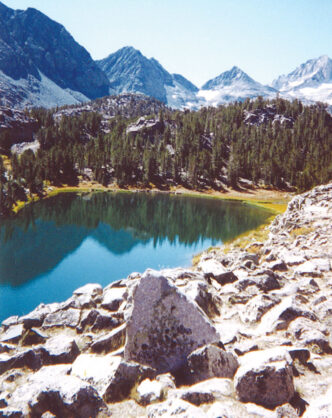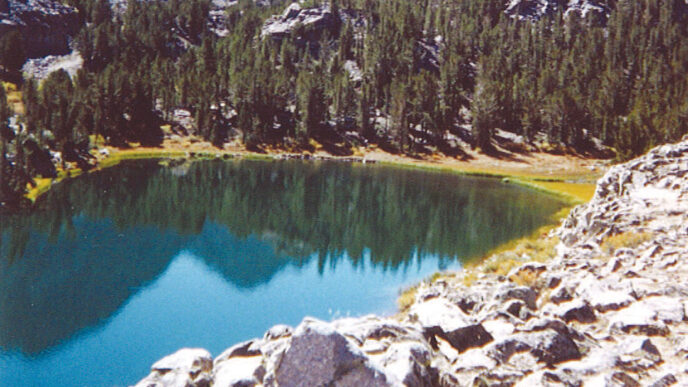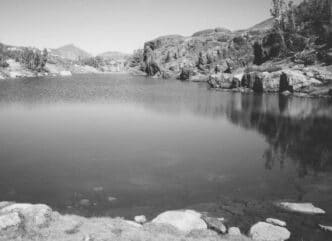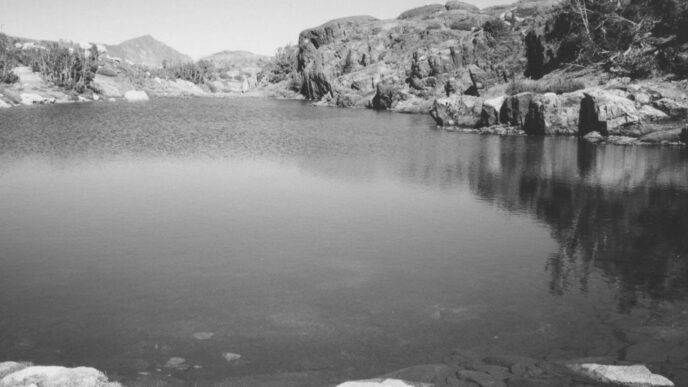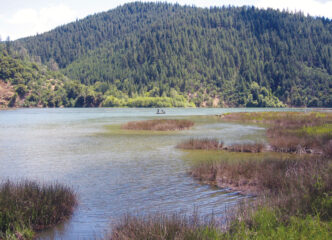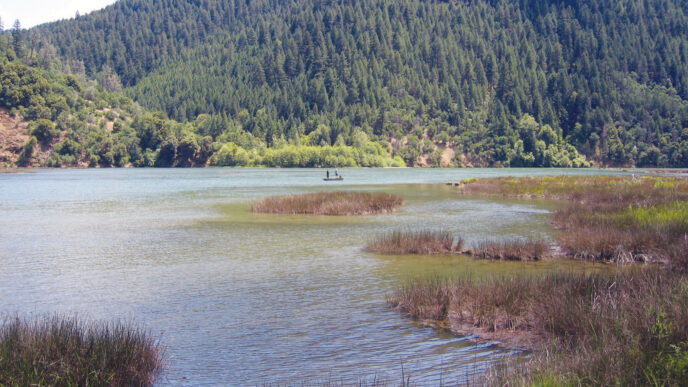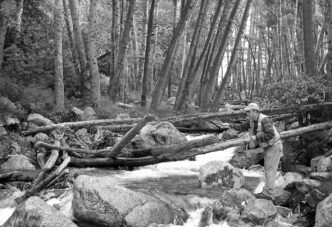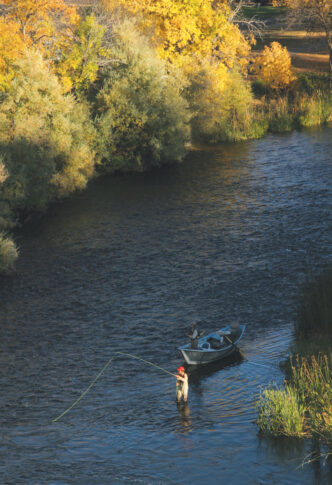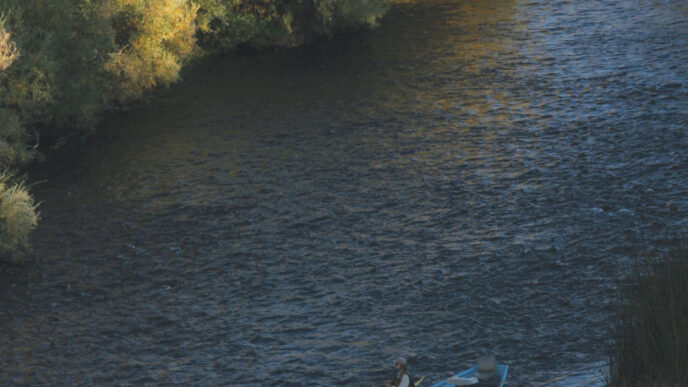My first visit to Clear Lake was in the early 1950s. My mother and father had heard of the excellent fishing for crappies and bluegills, and they hoped it would remind them of their experiences in Texas, their native state. Mom and Dad found what they were looking for, and a young boy who was mesmerized by any body of water, however large or small, reveled in watching bobbers being teased, then pulled under by hungry panfish that were filleted, dipped in a flour/cornmeal batter, then fried on the porch of a shantylike lakeside cabin as only Southerners can fry them.
My next visits were in the early 1970s after college, graduate school, and a visit to Southeast Asia. It was a bit of a disappointment in that my wife accompanied me on the first excursion, and she was not impressed by the condition of our accommodations, the availability of a decent meal, and the algae that plagued Clear Lake in the hot summer months. She did not return with me for many years.
It wasn’t until years later, when Andy Puyans and I partnered on a project to photograph some historic bass bugs, that I rediscovered Clear Lake. I had a 35-millimeter camera with an intraoral setup that had both a ring flash and a point flash. I used it in my dental practice for documenting the “before” and the “after” in cosmetic cases. It was also perfect for photographing bass bugs.
We took pictures of the vintage Joe Messinger and F. H. Peckenpaugh bugs that were in Andy’s collection and of some early East Coast patterns that I later copied for my own use. One of my favorites was Helen Shaw’s Bubble Pup, a hair-and-hackle bug that would land softly as well as burble. A surprise in the assortment were the handmade balsa popping bugs from Lucky Lloyd Isseman of Clear Lake. Lucky, a disabled World War II fighter pilot, took up residence at Clear Lake and fished out of a small wooden skiff that he propelled with a single sculling oar. He fished with a bamboo fly rod in one hand and sculled the boat with the other. Andy met Lucky when Lucky was living in a lakeside trailer park, guiding for black bass and selling his bugs commercially. Lucky’s wife was a character in her own right. I am fortunate to have some of his poppers in my own collection. I still use one, but only when it’s tied to a 20-pound fluorocarbon tippet, which is standard for me at Clear Lake because of the heavy cover and the possibility of a monster bass.
Lucky’s bugs are remarkably durable. The paint is still good after 30 years, and the hooks never twist in the balsa body. They are also very castable because of a longer, tapering profile, have good balance in the water, and do the herky-jerky left-and-right dance when popped using a Loop Knot for the leader connection. If the hackle and tail feathers wear out, I just recycle the bug by tying on some new ones and continue using the spotted bodies that work so well. Black and white and classic red and white are favorites.
Lucky was a fly-rod pioneer in California. Unfortunately, I haven’t been able to dig up any more information on him, and I never had the good fortune to fish with him, but those photo sessions with Andy and the tales he told pointed me toward Clear Lake again with fly rods in hand. One rod was a James Henshall model made by Heddon. Henshall wrote the 1881 classic Book of the Black Bass. Andy presented me with the rod when we completed our bass-bug documentation project. It has been retired to a spot on the wall in my fishing room.
The introduction of threadfin shad, Dorosoma petenense, helped dramatically with the algae problem and also caused an explosion in both size and numbers in the bass and crappie populations. Unfortunately, back-to-back low-water years resulted in dramatically reduced threadfin populations, which in turn has cut down the numbers and size of the game fish in the lake. It’s still good and worth a trip, though. This year’s high water levels suggest a late and very good spawn. It’s the same old story in California: Water solves a lot of problems.
Clear Lake was one of the early sites where Florida-strain bass were introduced in California. There are lots of big bass there and lots of shoreline cover that makes fly-rod fishing feasible. Tournament bass anglers have discovered Clear Lake, and this June, a friend and I fished with a rising star in the bass-pro angling world, Russ Snyders. In two days with him, my partner, Phil Drees, and I learned more about bass habits than we had learned in years on our own. We watched bass on their beds for hours and observed how they reacted to different lures, flies, and presentations. We learned more about how the fish move in and out of deeper water and probed backwaters and sloughs. Russ didn’t spare the gas in showing us everywhere on the lake that he thought could be productive for us with fly rods, and he was constantly passing on everything that he knew about the lake and its fish. It took me 10 minutes every evening to clean the bugs off my sunglasses. I didn’t tell my wife how fast the 20-foot Ranger with a 225-horsepower Mercury was flying, but she commented on my new hairdo. I think it is a perm!
The influx of anglers brought by the tournament bass crowd has helped the economy of Lake County, one of California’s poorer counties, and although in the early days Clear Lake was very weak on accommodations and decent restaurants, today, efforts to clean up the Grapes of Wrath look of certain areas and a revitalization program have produced results and amenities that make a visit attractive above and beyond the angling for bass, panfish, and catfish. Lakeside shanty like cabins are still there, but you will also find nice inns, high-end resorts, B&Bs, and a lot more restaurants in all price ranges . . . also vacation rentals.
The Lake County region is also now known for outstanding wines. Perhaps the most notable are chardonnays and sauvignon blancs, along with some credible syrahs and barberas. In the spring and summer, entire hillsides with thousands of acres of green vines sweep the southern and western slopes of the basins, and neat vineyards are scattered throughout the region. In the fall, the vines turn golden and crimson and marry with the blazing “California gold” grasses in the Coast Range. The sight is breathtaking from the roadside or on the water.
The Blue Wing Saloon and Café
There has been a revitalization of the hamlet of Upper Lake, and the Blue Wing is the best restaurant on the north end of Clear Lake. It’s part of the restored Tallman Hotel complex. As a lover and restorer of a Victorian building, I find the structure, vivid colors, and décor very inviting. There are funky antique shops, a few boutiques, and an interesting bar in the two blocks of this laid-back town. Resident friends drive over from the Soda Bay area for dinner and music. The locals are friendly and don’t bite.
The Blue Wing offers live music for Sunday brunch and blues on Monday evenings, and has lots of events and winemaker dinners. A signature appetizer from the kitchen is risotto fritters in which goat cheese is paired with sun-dried tomatoes and spinach. It is served with a chipotle aioli. A fresh salmon picatta is pan-seared with lemon, parsley, capers, and white wine. Their best-selling dish is a Blue Wing burger that is a half pound of hand-formed premium beef.
Ceago
Jim Fetzer and his brothers made a fortune when they sold Fetzer to a multinational company a number of years ago. The Sundial Chardonnay label sold millions of cases of wine over the years. There was a seven-year noncompetition clause that prohibited his reentry into the wine business for a while. During that time, he bought up lakeside property on Clear Lake’s northwest shore between Nice and Lucerne, and today, an event center with spectacular gardens and vineyards sits at lake’s edge: Ceago Vinegarden. Soon, a long-awaited restaurant will open.
You can access Ceago by boat and tie up to a modern dock or drive through an entrance and watch sheep and chickens feeding between the grapevines, then walk through rows of lavender on the biodynamic farm. Jim and his family also grow his grapes biodynamically.
Ceago is worth a stop to see the gardens and neomission structures, but the wines in the tasting room are very good. I have a standing order for a split case on every trip. Half is their unique sauvignon blanc, which reminds us of an Italian vernacia, and the other six bottles are their spectacular syrah rosé, which pairs very well with anything at a summer barbecue or picnic. You can buy picnic items and eat in the courtyard or walk past flowering lavender to another structure at lakeside where music events are held. You ought to be at the dock when 20 or so “woodies” — restored wooden motorboats — fire up their antique engines and roar across the lake into the sunset. And there are a number of spots in the vicinity of Nice and Lucerne where good fly-fishing water can be accessed with a small boat or a float tube.
The Boathouse
This is a funky barbeque/steak/hamburger joint that you can drive or boat to in Nice on the north shore. I’ve eaten there many times and think well of their ribs and pulled pork, both of which are cooked on-site daily. In June, we had been on water from first light with Russ and got a welcome cup of coffee around 10 A.M. from the Boathouse’s kitchen. We returned by boat at lunch for pulled pork and sweet potato fries on the waterside deck. What redneck fisherman isn’t happy with a good pulled-pork sandwich, fries, and a draft beer while the Ranger is safely moored nearby? Stick with the beer and pass on the “wine by the glass,” though, or bring your own.
The restaurant is open to 9:00 at night every day of the week. This is a big plus at Clear Lake, particularly in the off-season. Check ahead everywhere you visit — you may have to make your own breakfast and dinner if you start early and finish late.
I’ve also gotten good information on the spring and fall bite from pro bass anglers who tied up at the Boathouse for a break from the weather. The north end of the lake fishes well in the spring, they said, when one to two degrees of rising water temperature brings on the bite. Rodman Slough, with its abundance of wildlife, is nearby and in a good water year is a great fly-rod spot that can be fished with float tubes or other small craft.
WaterColor at the Ferndale Resort
The WaterColor is a floating restaurant in a refurbished sternwheeler, the Clear Lake Queen, at Ferndale Resort, a neat, clean vacation center at lakeside that caters to bass anglers and boaters. We had a lovely dinner topside there last year. The food was much better than normal banquet fare. The parent restaurant is on the Ferndale property, and they are serving regular meals during the season at this time. In the off-season the restaurant, like many at Clear Lake, may be closed on weekdays. We like their late hours on weekends, because we fish until dark. They do have tables and barbecues at dockside, if you want to throw something on the “Q.” Dinner this trip was in the resort’s smaller, landlocked facility. My medium rare rib eye with fresh corn, crispy green beans, and garlic mashed potatoes was very welcome after a day on the water. June’s fishing trip saw us bunking in one of the resort’s moderately priced motel-like rooms. We could check on our boat and gear tied up to their nice dock from the chairs in front of our room. It makes a first-light departure very easy, and that sternwheeler’s lights guided us in at night. You can eat on the Clear Lake Queen Thursday through Sunday. You’re in the adjacent land facility the rest of the week. Always call for updated hours, as at any resort.
Zino’s Ristorante and Inn
We dined at Zino’s because WaterColor at nearby Ferndale was closed on a June Monday evening. The décor is a little dated, as is the case with many resort eateries, but we found the service and food to be quite good. An outside deck looked inviting, but warm temperatures kept us inside. A north view looked out on their accessible dock and the mountains across the lake. You can boat in for dinner in season, and the restaurant is angler friendly, staying open to 10:00 on weekend evenings. Owner Jan Mezoui said they won’t turn anybody away if they arrive late. This is a big plus at the lake! A signature dish is veal picatta, as is their fresh-ingredient cioppino in season. I was hungry and ordered a pork chop with a Dijon mustard sauce. The chop was over an inch thick, bone in, and came with a subtle, not overpowering sauce and a few tasty mushrooms. I could taste the subtle flavor, and the char marks were there.
If You Go…
The Blue Wing Saloon and Café, 9520 Main Street, Upper Lake. Phone: (707) 279-4293. On the Web: cafe-restaurant. Brunch on Sundays. Lunch starts at 11:00, dinner at 5:00, seven days a week. Entrées, $13 to $24, corkage $10. Visa and MasterCard accepted.
The Boathouse Bar and BBQ, 2685 Lakeshore Boulevard, Nice. Phone: (707) 274-1100. Open seven days a week, serving from 11:30 A.M. Entrées, $6.95 to $24.95. Dining room, bar, and outside waterfront deck. Boat tie-up.
Ceago Vinegarden, 5115 East Highway 20, Nice. Phone: (707) 274-1462. On the Web: http://www.ceago.com. Tasting room open daily, 10:00 to 5:00. Call for the new restaurant’s hours. Boat tie-up.
Ferndale Resort and Restaurant (WaterColor and the Clear Lake Queen), 6190 Soda Bay Road, Kelseyville. Phone: (707) 279-4866. On the Web: www.ferndaleresort.com. Brunch, Saturday and Sunday, 9:00 to 2:00; dinner, Thursday through Sunday, 5:00 to 9:00. Dinner entrées, $17 to $22. Visa and MasterCard accepted. Boat tie-up.
Zino’s Ristorante and Inn, 6330 Soda Bay Road, Kelseyville. Phone: (707) 279-1620. On the Web: http://www.zinoclearlake.com. Dinner, 5:00 to 9:00, weekends to 10:00. Entrées, $12.99 to $30.00, corkage $10.00. Visa and MasterCard accepted. Boat tie-up.
Russ Snyders Fishing Guide Service. Phone: (650) 740-7735. On the Web: http://www.russnyders.com. E-mail: RusSnyders@gmail.com.
Trent Pridemore






